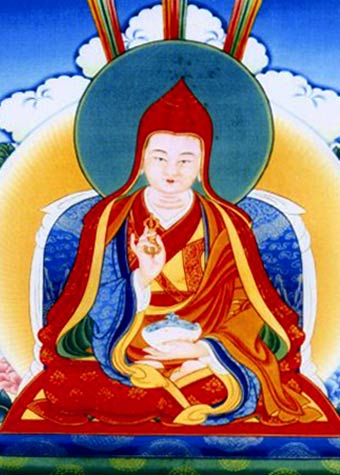Jamyang Khyentse Wangpo was recognized as the rebirth of Rinzin Jigme Lingpa, Nesar Jamyang Khyentse Wangchuk and Thartse Champa Namkha Chi-me (the 44th throne holder of the Ngor Monastery of the Sakya Tradition).
As Jigme Lingpa, he was also the manifestation of King Trisong Detsen, Vimalamitra, and many other masters. He was the master of thirteen lineal orders and was regarded as one of the five kings among the hundred major tertons of the Nyingma tradition.
Jamyang Khyentse Wangpo was born near Khyungchen Trak in a family of the Nyo clan from the village of Dilgo in the Terlung Valley of Derge amid wondrous signs on the fifth day of the sixth month of the Iron Dragon year of the fourteenth Rabjung (1820).
Jamyang Khyentse learnt to read at the age of four or five, and from an early age his intelligence grew so keen he was able to master reading, writing and other skills without any difficulty. At twelve, he was recognized by as the incarnation of the great khenpo of Evam Tharpatse, Jampa Namkha Chimé, and then was given the name Jamyang Khyentse Wangpo. At twenty-one, he received full ordination. In all, he had more than one hundred and fifty teachers, who were great masters from all four major schools—Sakya, Geluk, Kagyü and Nyingma—from the regions of Ü and Tsang, as well as eastern Tibet.
Through his studies in the ordinary sciences of craft, medicine, grammar and logic, and the various secondary disciplines, as well as the major treatises of the causal vehicle of characteristics on Madhyamika, Prajñaparamita, Vinaya and Abhidharma, and the profound instructions of the tantras such as Chakrasamvara, Hevajra and Guhyasamaja, as well as Kalachakra and other tantras of the resultant vehicle of Secret Mantra, he dispelled any doubts and misconceptions.
He studied with masters from every authentic tradition of practice with an unbroken lineage which existed at that time in the Land of Snows, but especially the so-called “Eight Great Chariots of the Practice Lineage”*.
Khyentse Wangpo made Dzongsar Tashi Lhatse Monastery of the Sakya tradition in Derge his main seat and rebuilt it after the destruction caused by Nyakrong forces. He constructed many temples and libraries, and inspired thousands of people to undertake activities on behalf of Dharma. He commissioned the building of about two thousand statues, the copying of about two thousand volumes of scripture, the carving of wooden blocks for about forty volumes, the making of more than a hundred copper statues gilded with gold, and the repair of many historical temples and monasteries.
For many decades he gave teachings and transmissions to disciples of different traditions.
At seventy-three, at the beginning of the first month of the Water Dragon year (1892), he said that he kept seeing Amitabha Buddha in the midst of an ocean of disciples. After the completion of an elaborate ceremony on the twenty-fifth day of the first month, he said to his offering master, “From now on you don’t have to do anything.” The next day he started to show ill health. His disciples asked, “What prayers should we do for your longevity?” He replied, “None. Around the twentieth of next month, I will have recovered.” When they insisted, he said, “It will be good if you say as many hundred-syllable mantras of Vajrasattva as you can.”
Then in the morning of the twenty-first of the second month, he washed his hands and said, “Now take everything away [from my table]. All my work is completed.” Then, uttering lots of prayers of auspiciousness, he threw grain flowers, which is a sign of completion. Later that day, he was withdrawn into the expanse of the enlightened mind of Vimalamitra. In the surrounding land there were gentle earthquakes. Even after death, his face looked radiant like the face of the moon. His body became as light as if it were made of cotton.
Jamyang Khyentse Wangpo manifested many incarnations simultaneously. Among them, Kathok Khyentse Chökyi Lodrö is considered as the most outstanding teacher. After the death of Dzongsar Khyentse, Kathok Khyentse moved to Dzongsar Monastery, the seat of the previous Khyentse Wangpo, and since then Kathok Khyentse became known as the Dzongsar Khyentse. The present Dzongsar Khyentse Rinpoche is the principal incarnation of Jamyang Khyentse Chökyi Lodrö.
*The Eight Great Chariots of the Practice Lineage is the eight major practice lineages of Tibetan learning and attainment, which were transmitted from India to Tibet. These eight major practice lineages are:
•Nyingma (the teachings of the Ancient Translations, which had come down in an aural lineage transmitted by Guru Padmasambhava)
•Kadam (divine teachings by Lord Atisha, later developed by the Gelug tradition)
•Lamdre (the essential instructions of the “Path with its Result” by Virupa, the origin of the Sakya tradition)
•Marpa Kagyü (the whisper lineage that stems from Marpa)
•Shangpa Kagyü (the whisper lineage from Niguma)
•Shyijé and Chö (the noble teachings of the “Pacifying of Suffering” tradition coming from Padampa Sangyé together with the profound teachings on the objects of severance, or Chö)
•Jordruk (Kalachakra/Six Branch Practice of Vajrayoga; developed into several branches and Jonang is one of them.)
•Nyendrub (the teachings transmitted by Orgyenpa Rinchen Pal)

